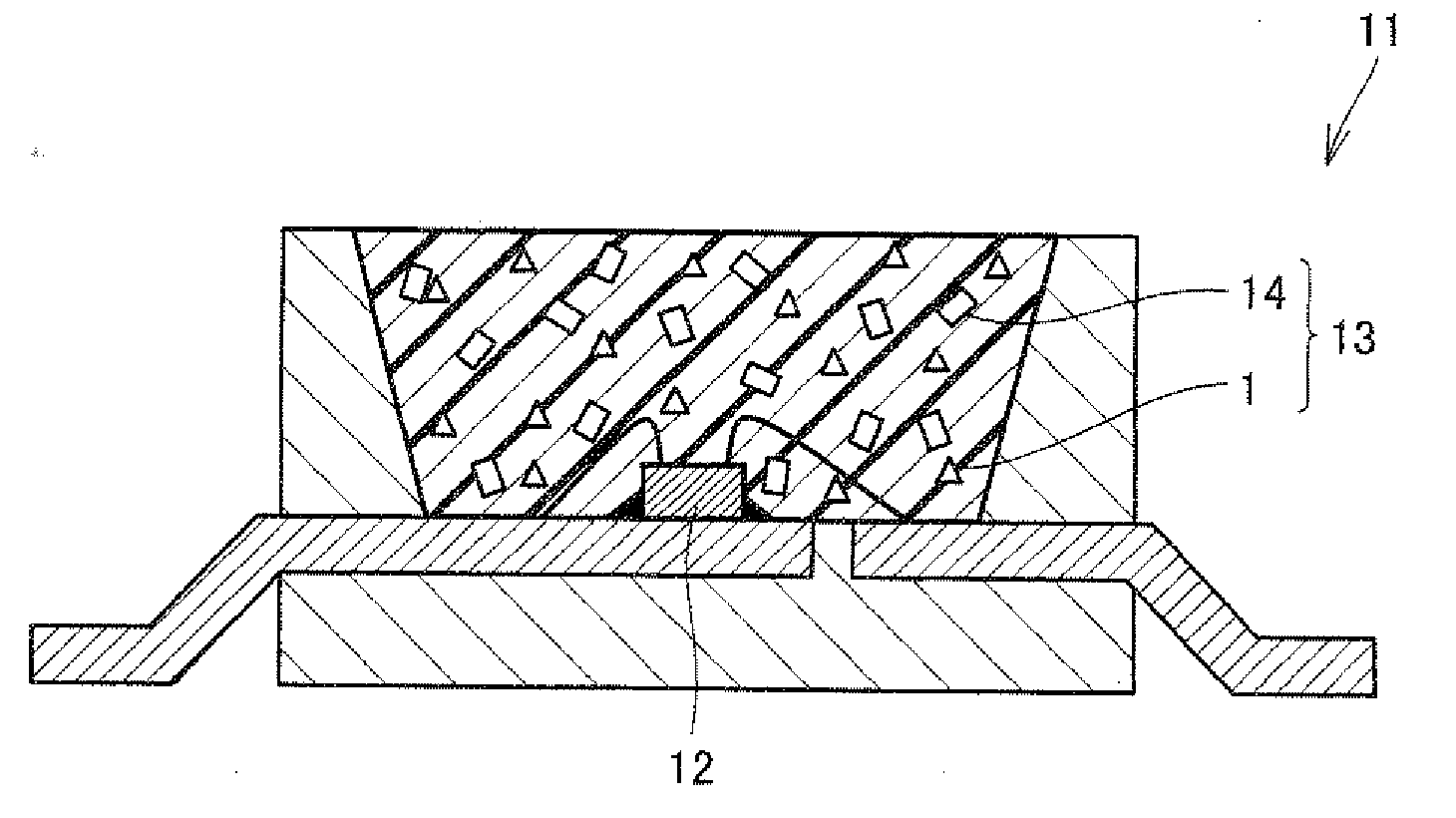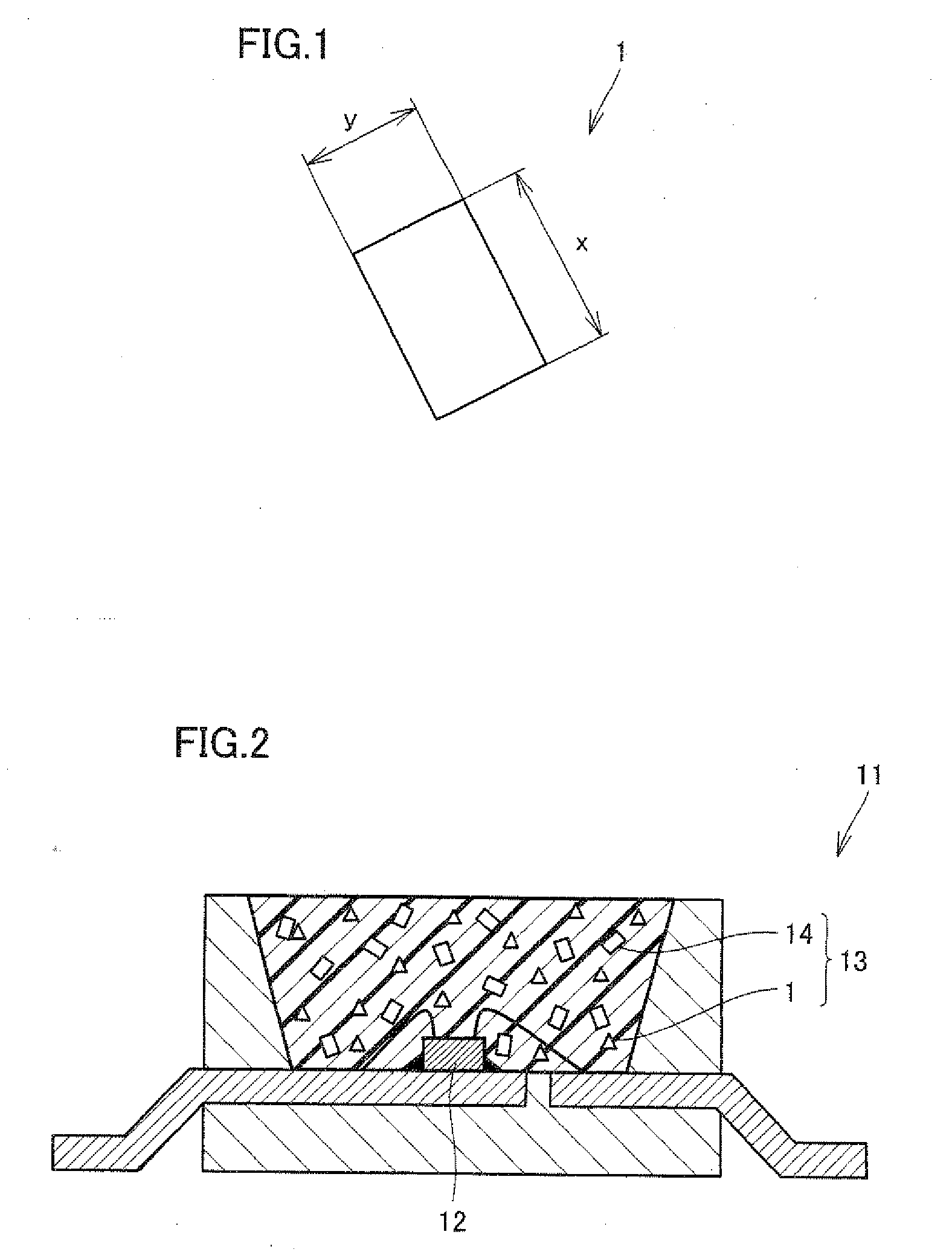Phosphor particle group and light emitting apparatus using the same
a technology of light emitting apparatus and phosphor particle group, which is applied in the direction of discharge tube/lamp details, luminescnet screen, transportation and packaging, etc., can solve the problems of inability to set input energy at high status, inability to obtain brightness, and inability to achieve high status, etc., to achieve excellent color gamut (ntsc ratio), efficient absorbing primary light, and high efficiency
- Summary
- Abstract
- Description
- Claims
- Application Information
AI Technical Summary
Benefits of technology
Problems solved by technology
Method used
Image
Examples
example 1
Comparative Example 1
[0042]A gallium nitride (GaN)-based semiconductor having a peak wavelength of 450 nm was used as a light emitting element. A light converter was produced by using a phosphor particle group, which was a particle group of green light emitting phosphor particles having a composition of Eu0.05Si11.50Al0.50O0.05N15.95 (β-type SiAlON) (D50: 7.8 μm), and 85% of which was composed of particles with the value obtained by dividing the longer particle diameter by the shorter particle diameter being greater than 1.0 and not greater than 3.0. The phosphor particle group was prepared by optimizing the oxygen concentration. Here, LA-920 (manufactured by HORIBA. Ltd.) was used as a particle size distribution measuring equipment. The light converter was fabricated by dispersing the phosphor particle group in a prescribed proportion in a sealing material made of thermosetting silicone resin as a medium and then sealing in a light emitting element. A light emitting apparatus of Ex...
examples 2-7
Comparative Examples 2-7
[0045]Light emitting apparatus of Examples 2-7, Comparative Examples 2-7 were produced in the manner similar to Example 1 except the proportion (%) of particles with the value obtained by dividing the longer particle diameter by the shorter particle diameter being greater than 1.0 and not greater than 3.0, and D50, and the light emitting elements, as shown in Table 2. The results of the characteristic (brightness) measured in the manner similar to Example 1 are also shown in Table 2. Table 2 shows that the light emitting apparatus of Examples 2-7 are superior in characteristic (brightness) to the light emitting apparatus of Comparative Examples 2-7.
TABLE 2proportion ofphosphor particles having the valueobtained by dividingthe longer particlepeakdiameter by the shorterwavelengthparticle diameter ofmedianof lightbrightnessgreater than 1.0 andvalueemitting(relativenot greater than 3.0(D50)elementvalue)Example 280% 8.6 μm440 nm104.5%Comparative50% 8.3 μm440 nm100...
example 8
Comparative Example 8
[0046]A gallium nitride (GaN)-based semiconductor having a peak wavelength of 460 nm was used as a light emitting element. A light converter was produced by using: a phosphor particle group, which was a particle group of green light emitting phosphor particles having a composition of Eu0.01Si11.80Al0.20O0.04N15.96 (β-type SiAlON) (D50: 10.5 μm) and, 85% of which was composed of phosphors with the value obtained by dividing the longer particle diameter by the shorter particle diameter being greater than 1.0 and not greater than 3.0; and a divalent europium-activated nitride red light emitting phosphor having a composition of (Ca0.99Eu0.01)AlSiN3 (D50: 9.3 μm). The above-noted phosphor particle group was prepared by optimizing the temperature profile at a time of synthesis. Here, LA-920 (manufactured by HORIBA Ltd.) was used as a particle size distribution measuring equipment. The light converter was fabricated by dispersing the phosphor particle group and the red...
PUM
| Property | Measurement | Unit |
|---|---|---|
| Fraction | aaaaa | aaaaa |
| Diameter | aaaaa | aaaaa |
| Nanoscale particle size | aaaaa | aaaaa |
Abstract
Description
Claims
Application Information
 Login to View More
Login to View More - R&D
- Intellectual Property
- Life Sciences
- Materials
- Tech Scout
- Unparalleled Data Quality
- Higher Quality Content
- 60% Fewer Hallucinations
Browse by: Latest US Patents, China's latest patents, Technical Efficacy Thesaurus, Application Domain, Technology Topic, Popular Technical Reports.
© 2025 PatSnap. All rights reserved.Legal|Privacy policy|Modern Slavery Act Transparency Statement|Sitemap|About US| Contact US: help@patsnap.com


